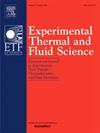Influence of the side ratio and main longitudinal beam shape on vortex-induced vibration and aerodynamic force characteristics of Π-shaped composite girders
IF 2.8
2区 工程技术
Q2 ENGINEERING, MECHANICAL
Experimental Thermal and Fluid Science
Pub Date : 2025-03-11
DOI:10.1016/j.expthermflusci.2025.111474
引用次数: 0
Abstract
Π-shaped composite girders in long-span bridges are prone to vortex-induced vibrations (VIVs). Therefore, it is important to study their VIV characteristics and corresponding countermeasures. In the present study, the effects of the side ratio (B/H = 7.00–14.00, where B and H represent the width and height of the girder, respectively), the bottom plate width of the main longitudinal beam (b = 0.30H–1.50H), and the inclination angle (β = -20°–30°) on VIVs, aerodynamic characteristics, and flow patterns were comprehensively compared. Additionally, the mechanisms underlying VIV suppression were preliminarily explored. The results indicate that the side ratio and the shape of the main longitudinal beam of the Π-shaped composite girder significantly affect the VIVs. However, the influence patterns differ and are highly related to the wind attack angle and vibration mode (vertical and torsional). The distribution patterns and values of the mean and fluctuating pressure coefficients on the upper and lower surfaces of the Π-shaped composite girder are different. These are notably influenced by the side ratio and β but are almost unaffected by b. VIVs are typically suppressed when the surface pressure frequency distribution becomes scattered and the pressure amplitude spectrum shows no distinct dominant frequency. Additionally, A reduction in the size of surface vortices is beneficial for controlling vertical VIVs. However, when the vortices are concentrated at the front of the model, they will induce torsional VIV. Within the studied parameter range, the optimal parameter combination for suppressing VIVs is B/H = 10.00, b ≥ 1.00H, and β = 10°. In general, practical engineering applications should consider specific conditions, such as the characteristics of the incoming flow.
边比和主梁纵形对Π-shaped组合梁涡激振动及气动力特性的影响
Π-shaped大跨度桥梁组合梁易发生涡激振动。因此,研究它们的涡激特性及相应的对策具有重要意义。在本研究中,综合比较了侧比(B/H = 7.00-14.00,其中B和H分别代表梁的宽度和高度)、主梁纵梁底板宽度(B = 0.30H-1.50H)和倾角(β = -20°-30°)对涡激振动、气动特性和流型的影响。此外,还初步探讨了VIV抑制的机制。结果表明:Π-shaped组合梁的边比和主纵梁的形状对涡喷流有显著影响。然而,影响模式不同,并且与风攻角和振动模式(垂直和扭转)高度相关。Π-shaped组合梁上下表面平均压力系数和波动压力系数的分布规律和取值不同。当表面压力频率分布变得分散,压力振幅谱没有明显的主导频率时,涡激振动通常被抑制。此外,减少表面涡的大小有利于控制垂直涡动。然而,当涡旋集中在模型前部时,它们将诱发扭转涡动。在研究的参数范围内,抑制VIVs的最佳参数组合为B/H = 10.00, B≥1.00H, β = 10°。一般来说,实际工程应用应考虑具体的条件,如来流的特性。
本文章由计算机程序翻译,如有差异,请以英文原文为准。
求助全文
约1分钟内获得全文
求助全文
来源期刊

Experimental Thermal and Fluid Science
工程技术-工程:机械
CiteScore
6.70
自引率
3.10%
发文量
159
审稿时长
34 days
期刊介绍:
Experimental Thermal and Fluid Science provides a forum for research emphasizing experimental work that enhances fundamental understanding of heat transfer, thermodynamics, and fluid mechanics. In addition to the principal areas of research, the journal covers research results in related fields, including combined heat and mass transfer, flows with phase transition, micro- and nano-scale systems, multiphase flow, combustion, radiative transfer, porous media, cryogenics, turbulence, and novel experimental techniques.
 求助内容:
求助内容: 应助结果提醒方式:
应助结果提醒方式:


